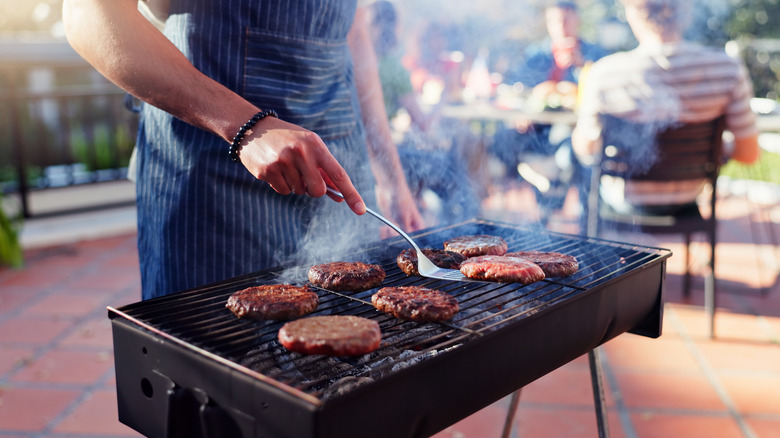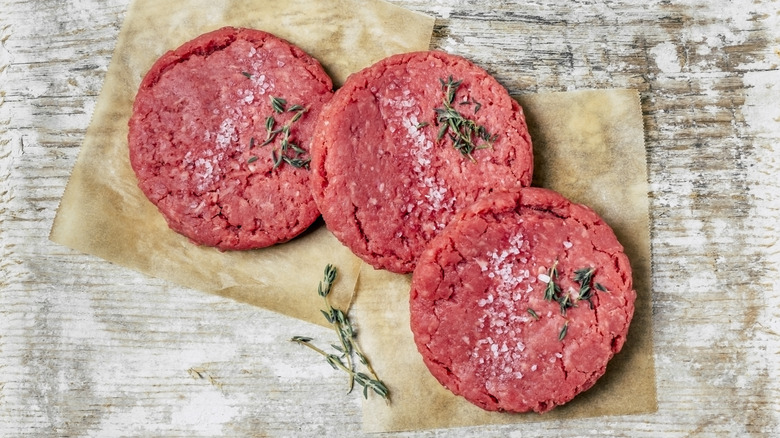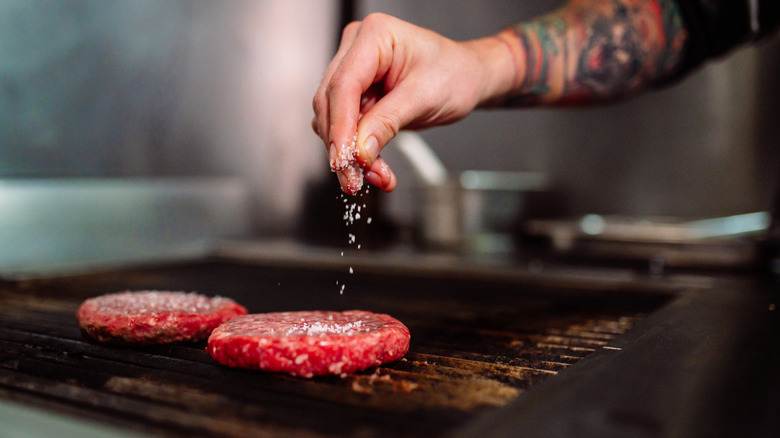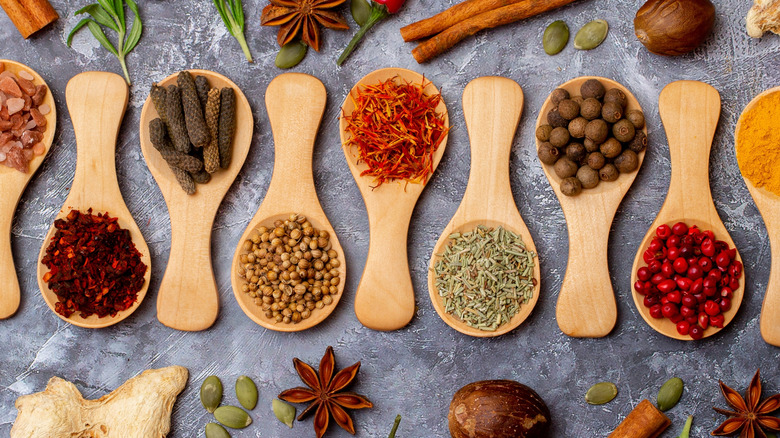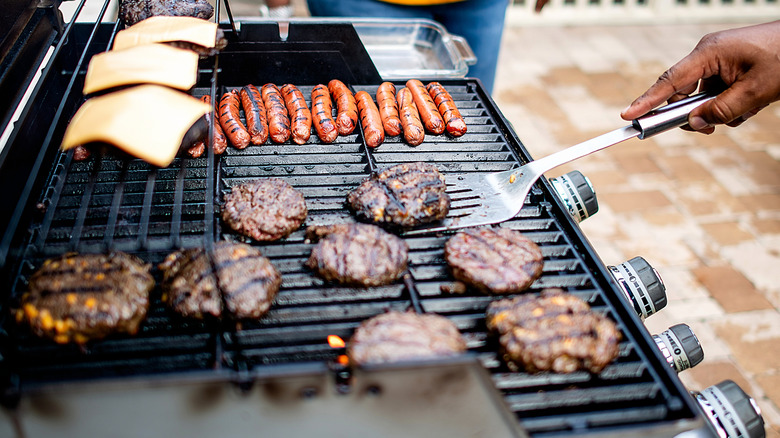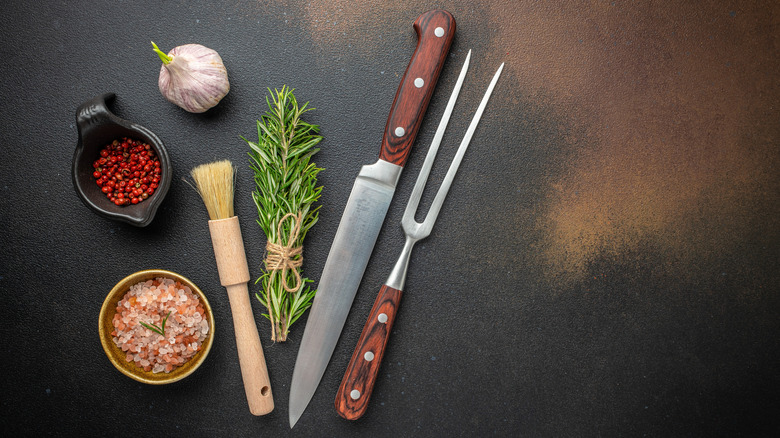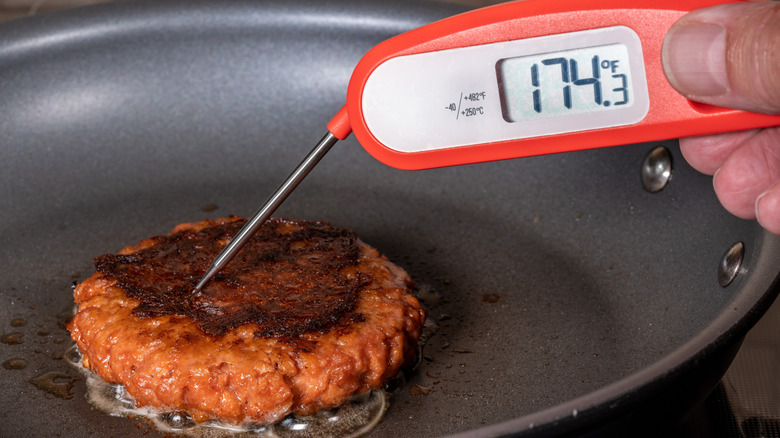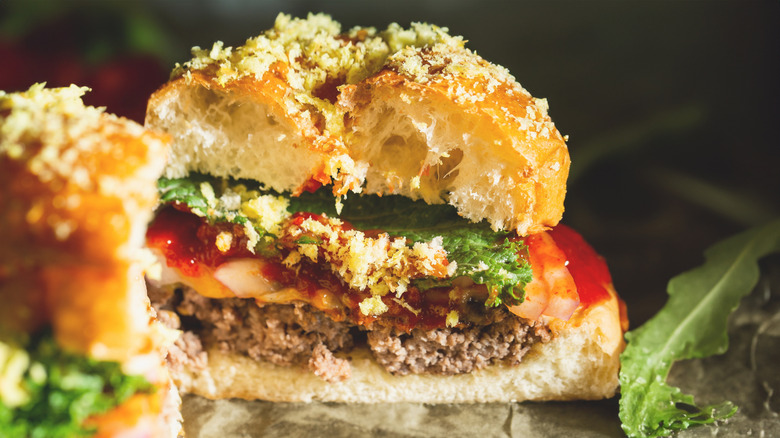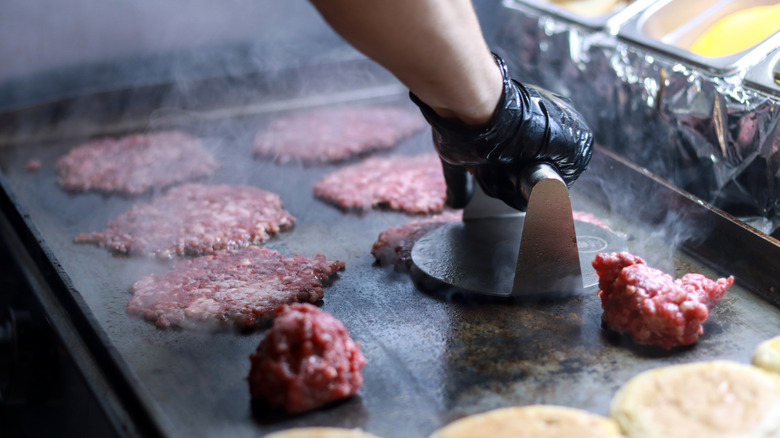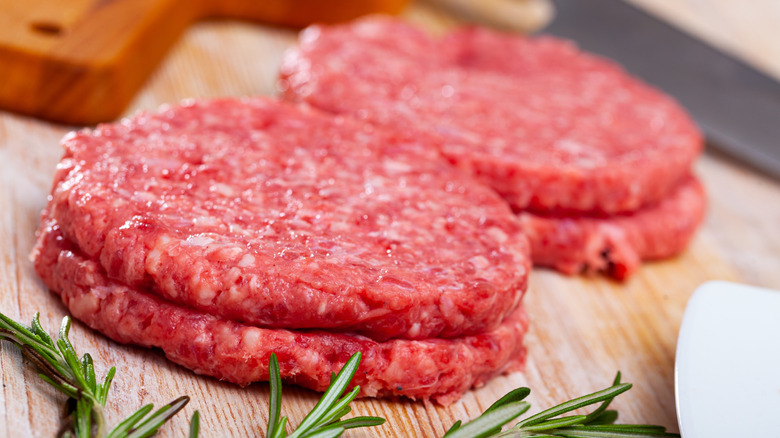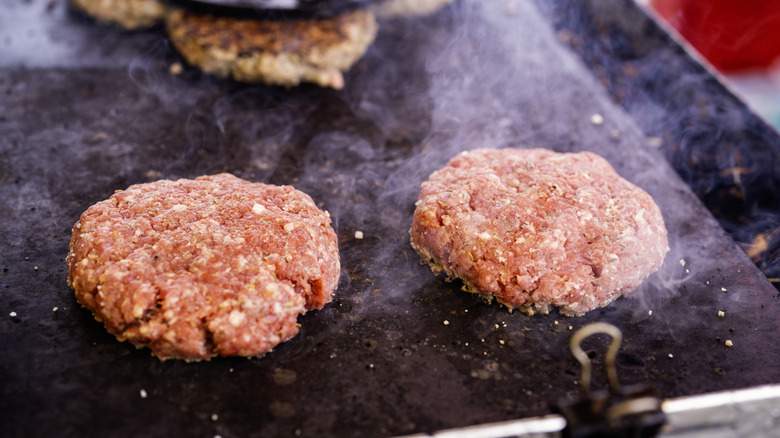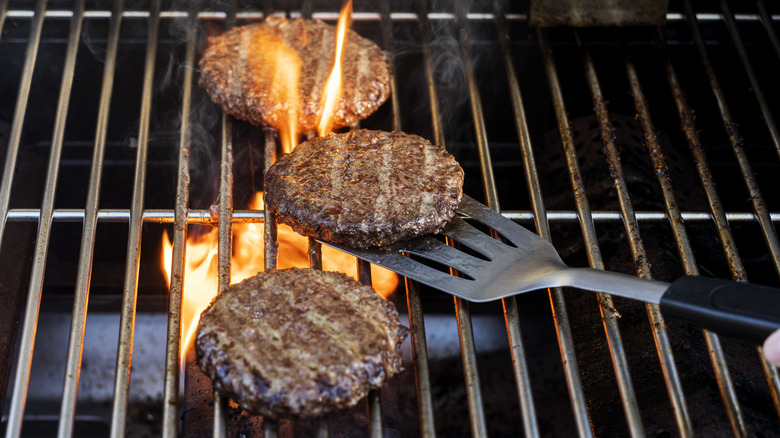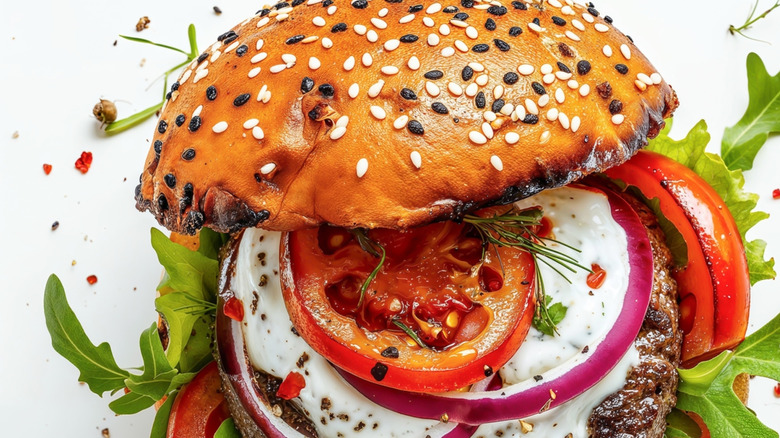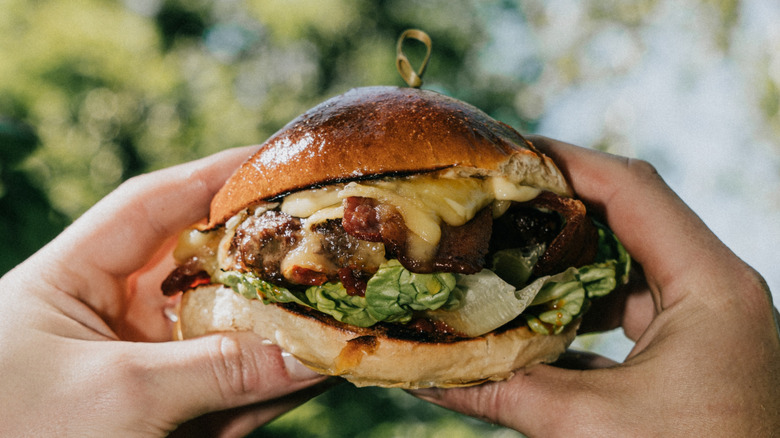Experts Reveal 15 Rules For Grilling Burgers Like A Pro
Nothing marks the beginning of summer like getting back behind the grill. After a bitter season full of hearty meals indoors, juicy, piping hot burgers are a summer staple that are long-awaited through the cold, brutal winter. But before you get out there, ask yourself: Are you making the best burger possible? Or are you making crucial mistakes preventing you from living your best grilling life?
Even the most experienced griller can commit classic mistakes: overworking the meat, not grilling at the right temperature, or using the wrong seasoning (and too much of it).
We asked the experts for their rules for grilling the perfect burgers and how home cooks can avoid critical mistakes. We consulted experts Lisa Lotts, owner of Garlic and Zest; Ashley Lonsdale, chef-in-residence at ButcherBox; Alvin Cailan, chef/owner at Local Kitchens; Marissa Stevens, recipe developer at Pinch and Swirl; and Mackenzie Burgess, RDN, registered dietitian nutritionist and recipe developer at Cheerful Choices, for all their burger musts.
Get your priorities straight
The first step in becoming a master griller is knowing your top priorities when you step behind the grill. Your priorities might be different from your neighbor's, and that's okay, as long as you know what you need to do to execute the perfect barbecue. Some people focus on temperature, some focus on prep. For chef Ashley Lonsdale, the correct temperature is everything. "My aim is to get the burger to the correct temperature while also achieving a deep brown crust on the outside because color = flavor."
Seasoning is another top priority for many chefs. If you start with a bland burger, you've got nothing. A properly seasoned patty will bring you the earthy, beefy flavor of the burger, and you'll have to rely less on toppings and condiments to make an enjoyable eating experience. Once her patties are perfectly seasoned, Mackenzie Burgess, RDN and recipe developer at Cheerful Choices, makes sure to "avoid overcooking, and locking in flavor with high heat." With this method, the juiciness and flavor of the meat will be preserved.
Season before grilling
The general consensus from experts is to season your meat right before it goes on the grill. This can help form a better sear on the patty, as well as draw out and evenly distribute moisture throughout the burger. Recipe developer Marissa Stevens, Pinch and Swirl, forms the patties "without any seasoning, then season both sides generously with salt and pepper just before they hit the grill. Mixing salt into the meat tightens the texture too much — I want the inside tender, and the outside well-seasoned."
Having all of your seasonings in place before you start the cooking process can ensure your meat isn't left out to just sit there and warm up. "It's essential to have everything in place before beginning the process, or chill the patties before grilling if you're concerned they've warmed too much," says Ashley Lonsdale, chef-in-residence at ButcherBox. Getting all your ingredients and seasonings ready to go is the key to success for any classic cookout burger.
Keep the seasonings simple
We asked the experts what their go-to method is for seasoning the perfect burger patty. The overwhelming answer? Good old salt and pepper. Chef Alvin Cailan, owner at Local Kitchens, says, "[You] can't go wrong with S&P; keep it simple!" Many home chefs overcomplicate things and can end up with unsatisfactory results by adding fillers to their patties ... when in reality, simpler is better. Simple seasoning is the key, Lisa Lotts, owner of Garlic and Zest, says, "You can get creative with toppings, buns, and sides."
If you want a twist on your seasonings, Mackenzie Burgess, recipe developer, likes to add " a mixture of granulated onion, garlic powder, chopped fresh rosemary, ground black pepper, and flaky sea salt." Good burgers don't need a bunch of extra ingredients like breadcrumbs, chopped onions, or eggs. For the perfect burger, less is more.
Know the mistakes to avoid
Cooking burgers, like cooking anything, is a learning process. There are simple mistakes that home chefs make time and time again, and avoiding these mishaps can send your burger game skyrocketing.
One of the most common mistakes seen by experts is overworking your meat. "People tend to shape patties like they're making meatballs, which tightens the texture," says Marissa Stevens, recipe developer at Pinch and Swirl. While you don't want your burger to fall apart on the grill, you also don't want to handle it to the point of seizing up and having an undesirable texture. Stevens suggests, "You want a light touch — just enough to hold the shape."
Another common mistake is using the wrong gear. Even home chefs can use gear that will replicate, or get close to replicating, a restaurant-style burger. "A nonstick pan and a slotted spatula aren't going to cut it if you're chasing that restaurant-style burger. You need a cast iron or a flat top, a sturdy burger spatula, and a way to manage heat. Once you've got the right setup, everything changes," advises chef Alvin Cailan of Local Kitchens.
Find the perfect ratio
Junior grillers may believe the leaner the beef you can find, the better. However, there's a ratio that almost all experts agree on: 80/20. While you may be hesitant at first, fat is your friend when it comes to grilling. Marissa Stevens, Pinch and Swirl, says this ratio provides "the right fat ratio for flavor, juiciness, and a good sear. Anything leaner and you're working against yourself on the grill." You can increase customization to your burger by blending different types of beef, such as chuck and sirloin, but this isn't a necessity. Any 80/20 ground beef will give you a juicy, flavorful burger. If you go too lean (which can be the worst kind of burger to grill), you risk a dry, difficult burger.
Don't limit yourself to ground beef, though. While it's a cookout staple, there are many flavorful options like turkey burgers, chicken burgers, and even salmon burgers to try.
Grill over direct heat
Depending on the cook, grilling over indirect heat or direct heat may come down to personal preference. However, the experts generally differ on starting with direct heat. The immediate heat hitting the cool patty will give you a beautiful sear without drying the burger out. Marissa Stevens, recipe developer at Pinch and Swirl, likes to "sear over direct heat, then finish over indirect if it hasn't reached the internal temperature I'm after — it gives more control without drying the burger out." The key is to maintain control so that you don't end up with a burger that tastes charred or overdone.
The above method works best for most average-sized patties, but if you're working with something larger, you can switch up your cooking method. Alvin Cailan, chef/owner at Local Kitchens, mentions that when working with pub-style burgers, "if you're working with thick patties, reverse sear is a solid move. Low and slow to temp, then sear it off hot for that crust."
Practice good kitchen hygiene
Perhaps the most foundational skill of any grill master is good kitchen hygiene. If you're working with a messy station or tools that haven't been properly cleaned, any meal you make is null. There are several ways to get your grill squeaky clean before use. Mackenzie Burgess, RDN, registered dietitian nutritionist and recipe developer at Cheerful Choices, offers these tips: "Make sure your grates are clean before cooking — I often rub lemon with salt over the grates to help clean it. You can also scrub over a combo of baking soda with liquid dish soap." Another crucial cleaning point: If you're scrubbing your grill, avoid using wire brushes. The metal bristles can come loose from the brush and end up in your food while grilling.
For your tools, Marissa Stevens, Pinch and Swirl, suggests using "separate tools for raw and cooked meat, and avoid brushing sauces or seasonings with anything that has touched raw meat." She stresses the importance of keeping raw food tools vs. cooked food tools separate, including the plates you are serving the burgers on. "Remember to transfer cooked burgers to a clean plate, not the one you brought the raw burgers out on. These are all easy steps to overlook when you're outside and multitasking."
Check the internal temperature
You want to make sure your burgers are the perfect level of doneness for your guests, but don't want to hack the burger to pieces, making sure it's the right shade of pink in the middle. For this, experts suggest getting familiar with a meat thermometer. To make sure your burgers are cooked to everyone's liking, temperature is the only true test.
For a medium-rare burger, you want to aim for a temperature around 130-135 F. For every degree of doneness, add another 5-10 F. Chef Alvin Cailan, chef/owner at Local Kitchens, gets even more precise: "128 F is my personal sweet spot for a medium-rare burger. Over 140 F and you're drying it out. You can't time it by minutes because your grill and mine aren't the same. Temp is truth." Using a meat thermometer is really the only way to know if the inside of the burger is cooked all the way through.
Keep it juicy
One of a griller's biggest fears is serving a dried-out burger. So, how can you preserve those natural juices and avoid serving a hockey puck to your guests? The biggest tip: Leave it alone. "Resist the urge to constantly check or move them around," says Mackenzie Burgess, recipe developer at Cheerful Choices. Don't flip too much and don't move the burger around too often. "Never press the burger after the flip — you're squeezing out the juice," says chef Alvin Cailan. Even celebrity chefs like Bobby Flay suggest touching the meat as little as possible.
Resting patties right after cooking can guarantee juiciness as well. Marissa Stevens, Pinch and Swirl insists, "Let them rest before serving so the juices settle instead of running out." Many experts recommend letting the patties sit for a minimum of a couple of minutes to get the perfect internal temp, and letting them finish their cooking this way means the burger won't dry out on the grill. There are even specific wait times for cooking and resting your burgers, such as the 5-6-7 method.
Avoid pressing with a spatula
We've all seen the fry cooks in movies and TV shows pull the classic grilling move: pressing the patty down with their spatula to elicit that sizzling noise. But experts urge you to resist this move. Not only does it not help your grilling experience, but it can actually hinder it and negatively affect your burger. "Pressing down can force out juices and potentially dry out the burger," Mackenzie Burgess, Cheerful Choices, says. To avoid drying out, you want to retain as much of the juice as possible, and by pressing the burger down flat, you're wasting valuable liquid that will leave your burger rubbery and super dry.
The exception to this rule would be if you're making smash burgers. These thinner patties need a little press with a spatula or burger press to get the desired consistency and thickness.
Don't overwork your patties
When forming your burger patties, it's important to avoid overworking whichever meat you're using. Whether you're using ground turkey, salmon, or classic ground beef, any of these can get tough and rubbery if you spend too much time shaping and mixing them. Ashley Lonsdale, ButcherBox, says, "Take care not to let your hands' warmth heat the ground meat. If the meat is warmed, the fat may melt, which is juiciness lost inside the burger. If the meat is overworked, the proteins will tighten when cooked."
When handling meat, you want to "use your fingertips, not your palms, and handle the meat just enough to shape. When you're shaping, think 'patty, ' not 'meatball.'" says Marissa Stevens of Pinch and Swirl.
Don't let the patty stick
The dreaded scenario: You have your burger perfectly seasoned and hot on the grill, and as you're getting ready to flip it ... it sticks to the grill, and you're left with the destroyed remains of a perfect burger. So, how can you prevent the patty from sticking? First and foremost, you want to make sure your grates are squeaky clean. Debris and leftover material on the grill can stick to your burger patty.
Next, lightly oiling the grates can prevent sticking and give you a smooth flip. Marissa Stevens, recipe developer at Pinch and Swirl, oils the grates just before the patties go on the grill, and she says, "I don't try to flip too early — if they're sticking, they're not ready." If the grill is hot enough, the burger will naturally release from the grill once a crust forms and the meat is done on that side. Don't pull up too early, as Alvin Cailan, chef/owner at Local Kitchens, says. "A hot surface means the meat will release naturally once the crust forms. Cold grill = stuck patty = heartbreak."
Get a great sear
In order to get those picturesque grill marks on your burger, you want to make sure your grill is good and hot. Grill temps of at least 420 F are a must, and ideally, you should be in the 450-475 F range. At this temperature, something called the Maillard reaction occurs, where the chemical change in the meat reacting to heat results in a delicious crust on the browning meat. Mackenzie Burgess, Cheerful Choices, technique is to "Cook at 420–450 F (medium high) to develop a good sear, and then move the patty to a new spot when flipping to achieve even grill marks."
If your grill isn't hot enough, the burger will more likely steam than sear, and your patties will end up rubbery with an unsettling grayish color. Giving the patty enough time to sit and sear is crucial during this step of the grilling process. Alvin Cailan, chef/owner at Local Kitchens, again prompts the "leave it alone" technique: "Let it be. Don't mess with it. Let the patty sit on a ripping hot surface and wait for the crust to build. When it's ready, it'll release — all it needs is a firm spatula and a little patience."
Keep it consistent
What are experts for, if not to give the inside scoop on their tricks of the trade? If you want perfectly consistent burgers every time, there are some tools and techniques that are tried and true by the best. According to Marissa Stevens, recipe developer at Pinch and Swirl, a meat thermometer is the holy grail. "A meat thermometer is a must as far as I'm concerned." This little tool comes up a lot with the experts, deeming it an absolute necessity for your grilling pursuits.
A technique that you may not already be using: Make a small thumbprint in the middle of each patty before grilling to help them cook more evenly. This way, the burger has an even thickness, rather than that "homemade-domed-look," says Lisa Lotts, owner of Garlic and Zest. If you've been battling the domed, uneven patty for one too many summers, this is the technique to try. Another tip you may not have tried: Place a small ice cube on top of your patties while grilling to ensure consistent moisture throughout.
Balance cook times with toppings
Completing your perfectly-cooked burger with your favorite toppings can be a delicate dance. If you wait too long to assemble, you'll end up with a cold burger. If you don't wait long enough, your burger may not be cooked correctly. Experts universally agree that adding cheese about one minute before cooking is complete will give you a melty masterpiece ready for other toppings. Covering the burger once cheese has been placed also ensures maximum melt. Once your cheese is all set, you can throw the burger on the bun and add other goodies.
Ashley Lonsdale, chef-in-residence at ButcherBox, lets us know: "Ingredients like bacon or caramelized onions are fine to be added when the burger patty hits the bun as long as they're already warm." Prepping these ingredients ahead of time is the key, as trying to get everything ready on the grill at once is a recipe for dry, overcooked meat.
Final words of wisdom
As you go into the grilling season armed with knowledge from the pros, take these final tidbits with you. Marissa Stevens, recipe developer at Pinch and Swirl, reminds you, "Don't overthink it. Season well, use good ingredients, and let the grill do the work. A short rest and a good bun go a long way."
Alvin Cailan, chef/owner at Local Kitchens, notes that the key is practice, practice, practice. "Keep cooking. Keep dialing it in. Make burgers until you love what you're serving. When you fail, fix it. When you nail it, replicate it. That's how you earn your stripes as a true burger master." You'll never know what works for you unless you try things over and over, finding your customized routine.
Don't be afraid to try new things the next time you grill. Trying a new type of burger and new techniques will make you a more versatile griller and enable you to make all of your friends and family happy this summer. Try these tips from our experts to have everyone running to your backyard for more.

